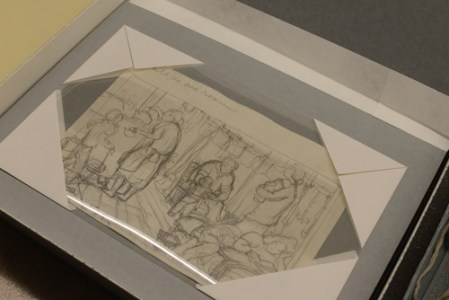
Buddhist Churches of America Archives.
JANM is fortunate to have a vast collection of artworks, artifacts, documents, and other historical items pertaining to the Japanese American experience. To help scholars and other researchers navigate its contents, the museum’s Collections Management and Access (CMA) Unit is an active contributor to the Online Archive of California (OAC), a web resource that provides free public access to detailed descriptions of primary resource collections at more than 200 libraries, archives, historical societies, and museums throughout California.
On OAC’s Japanese American National Museum page, you will find a hyperlinked, alphabetical list of collection finding aids. Click on any of the finding aids to access detailed information about that collection, including the scope and nature of its contents; background information and biographies; applicable restrictions; and instructions on how to access the collection. Some of the finding aids feature materials that can be accessed directly, such as digital copies of documents, and all of them offer a downloadable PDF of all the information. The museum regularly adds new finding aids after collections are processed.

JANM’s archivist recently completed the finding aid for the records of the Buddhist Churches of America (BCA), a national organization of the Jodo Shinshu Hongwanji-ha sect and the largest Japanese American Buddhist organization in the country. This collection was transferred to the museum from BCA headquarters and is jointly owned by both organizations. The finding aid represents a significant advance for the study of Japanese American history, since the arrival and growth of the Buddhist religion in America was closely tied to the arrival of the first Issei immigrants.
JANM’s sizable collection of materials dates from 1899, when the BCA was founded, to 2016. It includes correspondence between headquarters in the United States, Jodo Shinshu Hongwanji Headquarters in Kyoto, Japan, and individual temples, along with meeting minutes and conference materials, education-related records, publications, financial records, and audiovisual materials in a wide variety of formats. The collection spans three major periods in the evolution of BCA: establishment and early growth, the World War II incarceration era and its impact, and postwar expansion. Panoramic photographs from the collection are available to view on the museum’s website.
Also recently added was the finding aid for the Stanley Hayami Papers. Born in 1925 in Los Angeles, Stanley Hayami was incarcerated with his family at Heart Mountain and attended high school while he was in camp. After graduating, he was inducted into the US Army and joined the 442nd Regimental Combat Unit. In March 1945, during a tour of duty in Italy, Hayami was killed in action while trying to save another soldier. He was posthumously awarded a Purple Heart for his bravery.

Gift of the estate of Frank Naoichi and Asano Hayami, parents of Stanley Kunio Hayami.
JANM’s Stanley Hayami Papers includes letters from Stanley to his sister Sachiko, letters from Sachiko to her family in Heart Mountain, camp newspapers and newsletters, personal items belonging to Stanley (1945 diary, certificate of baptism, application for life insurance, report cards), items of Stanley’s clothing, photographs of soldiers, and drawings by Stanley. This collection captures his time with the 442nd; those interested in his high school years can go to the OAC website and view the Stanley Hayami Diary (1941-1944), which has been digitized and made available online.
Requests to access JANM’s permanent collection can be made by contacting the CMA Unit at 213.830.5615 or collections@janm.org. Appointments must be scheduled in advance and documentation as to the purpose of the research visit is required. Fees may apply.











![Estelle Ishigo (Gift of Mary Ruth Blackburn, Japanese American National Museum [2000.103.12])](https://i0.wp.com/media.discovernikkei.org/articles/4279/ishigo2.jpg?resize=269%2C215)











